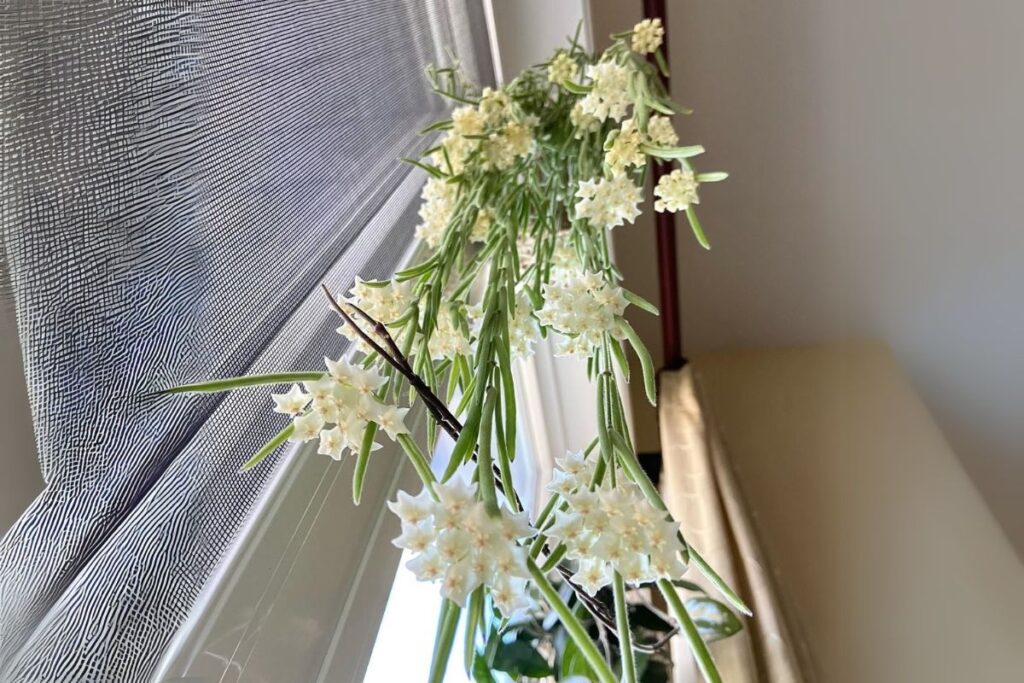If you’re a plant enthusiast looking to add a unique and eye-catching species to your indoor garden, Hoya Linearis might be just what you need. Known for its distinctive cascading foliage and delicate blooms, this tropical plant is a favorite among houseplant lovers.

Contents
Origin and Habitat
Hoya Linearis, native to the Himalayan regions of Nepal, Bhutan, and India, thrives in montane forests. Unlike many other Hoya species, which are typically found in lowland tropical areas, Hoya Linearis prefers cooler, high-altitude environments. This epiphytic plant naturally grows on trees, where it absorbs moisture and nutrients from the air.
Appearance
Hoya Linearis is renowned for its slender, trailing stems covered with narrow, soft leaves. These leaves are a light green color and have a slightly fuzzy texture, giving the plant a delicate and wispy appearance. When in bloom, Hoya Linearis produces clusters of small, white, star-shaped flowers that are mildly fragrant. These blooms add a touch of elegance and charm to any indoor garden.

Care Requirements
Light: Hoya Linearis thrives in bright, indirect light. It can tolerate some direct sunlight, but prolonged exposure may scorch its delicate leaves. Position your plant near a window with filtered light for the best results.
Watering: This Hoya species prefers a consistent watering schedule, allowing the soil to dry out slightly between waterings. Overwatering can lead to root rot, so it’s essential to ensure the potting mix is well-draining. During the growing season, water more frequently, while in the winter months, reduce the watering frequency.
Humidity: As a native of high-altitude forests, Hoya Linearis appreciates moderate to high humidity levels. If your indoor environment is dry, consider using a humidifier or placing the plant on a humidity tray to maintain the desired humidity levels.
Soil: A well-draining potting mix is crucial for Hoya Linearis. A combination of orchid bark, perlite, and peat moss or potting soil works well. This mix allows for proper aeration and drainage, preventing waterlogged roots.
Fertilizing: Feed your Hoya Linearis with a balanced, water-soluble fertilizer during the growing season (spring and summer). Fertilize every four weeks to support healthy growth and encourage blooming.
Propagation
Hoya Linearis is relatively easy to propagate, making it a great choice for expanding your collection or sharing with friends. The most common method is through stem cuttings. Here’s a step-by-step guide:
- Select a Healthy Stem: Choose a stem with several leaves and at least one node.
- Cut the Stem: Using a clean, sharp pair of scissors, cut just below a node.
- Rooting Medium: Place the cutting in water or a well-draining potting mix.
- Wait for Roots: Keep the cutting in a warm, bright spot and wait for roots to develop. This process can take a few weeks.
- Transplant: Once roots are established, transplant the cutting into a pot with fresh soil.
Common Issues
While Hoya Linearis is generally low-maintenance, it can encounter a few common problems. Here are some and their solutions:
- Yellowing Leaves: This can be a sign of overwatering. Ensure the soil is well-draining and adjust your watering schedule accordingly.
- Lack of Blooms: Insufficient light or nutrients can hinder blooming. Move the plant to a brighter location and consider fertilizing during the growing season.
- Pests: Hoya Linearis can attract pests like mealybugs and spider mites. Regularly inspect your plant and treat infestations with insecticidal soap or neem oil.
Benefits of Growing Hoya Linearis
Beyond its visual appeal, Hoya Linearis offers several benefits:
- Air Purification: Like many houseplants, Hoya Linearis helps improve indoor air quality by filtering out toxins.
- Low Maintenance: It’s a forgiving plant that doesn’t require constant attention, making it perfect for busy individuals.
- Decorative: Its trailing stems and delicate flowers make it a stunning addition to any home decor, whether hanging in a basket or draping from a shelf.
Hoya Linearis is a true gem in the plant world, offering beauty, elegance, and ease of care. Whether you’re a seasoned plant parent or a beginner, this versatile plant is sure to bring joy and greenery to your indoor space.
